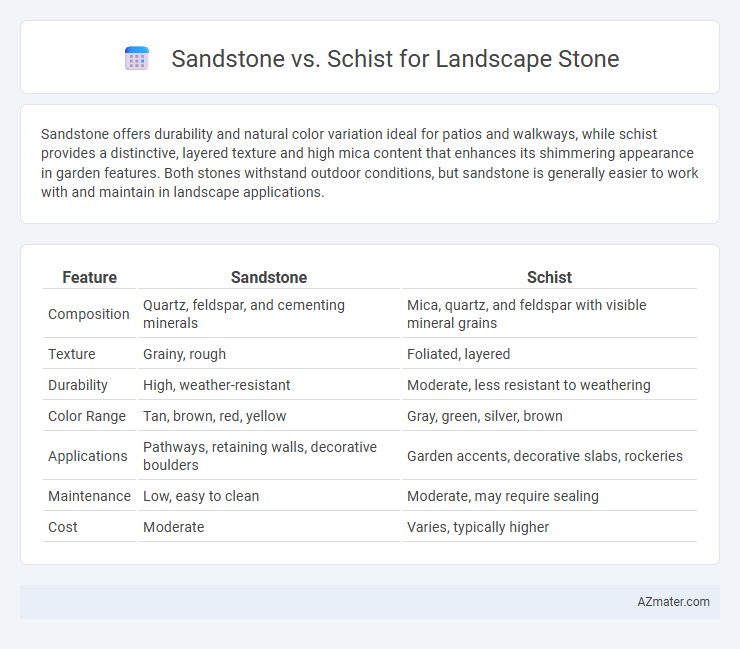Sandstone offers durability and natural color variation ideal for patios and walkways, while schist provides a distinctive, layered texture and high mica content that enhances its shimmering appearance in garden features. Both stones withstand outdoor conditions, but sandstone is generally easier to work with and maintain in landscape applications.
Table of Comparison
| Feature | Sandstone | Schist |
|---|---|---|
| Composition | Quartz, feldspar, and cementing minerals | Mica, quartz, and feldspar with visible mineral grains |
| Texture | Grainy, rough | Foliated, layered |
| Durability | High, weather-resistant | Moderate, less resistant to weathering |
| Color Range | Tan, brown, red, yellow | Gray, green, silver, brown |
| Applications | Pathways, retaining walls, decorative boulders | Garden accents, decorative slabs, rockeries |
| Maintenance | Low, easy to clean | Moderate, may require sealing |
| Cost | Moderate | Varies, typically higher |
Introduction to Sandstone and Schist
Sandstone and schist are popular choices for landscape stone, each offering distinct aesthetic and structural qualities. Sandstone, composed primarily of compacted sand particles, features a porous texture and warm earth tones that blend seamlessly with natural environments. Schist, a metamorphic rock characterized by its foliated layers and sparkling mineral grains, provides durability and a unique, textured appearance ideal for garden pathways and retaining walls.
Geological Formation and Characteristics
Sandstone forms from compacted sand grains cemented by minerals like quartz or calcite, featuring a granular texture and varying hardness depending on cementing agents, commonly used in landscapes for its durability and natural appearance. Schist originates from metamorphic processes where shale or mudstone undergoes heat and pressure, resulting in a foliated structure with visible minerals such as mica, making it ideal for decorative stone in gardens due to its layered texture and reflective surfaces. Both stones differ significantly in geological origin and physical properties, influencing their suitability and aesthetic qualities in landscape design.
Appearance and Color Variations
Sandstone offers a warm, earthy palette with shades ranging from tan and red to brown and yellow, featuring a generally smooth, granular texture that enhances natural landscapes. Schist displays a more varied and dramatic appearance characterized by its foliated structure, often showcasing shimmering mica flakes with color variations including gray, green, purple, and silver tones. Both stones provide distinct aesthetic qualities, with sandstone's uniformity complementing rustic designs and schist's textured layers lending a dynamic, rugged elegance to outdoor spaces.
Durability and Weather Resistance
Sandstone and schist differ significantly in durability and weather resistance when used as landscape stones. Sandstone, composed primarily of quartz grains, offers excellent durability and resists weathering, making it ideal for outdoor applications exposed to sun, rain, and freeze-thaw cycles. Schist, characterized by its foliated texture and mineral composition, is less durable and more prone to splitting and erosion under harsh weather conditions, reducing its longevity as a landscape stone.
Ease of Cutting and Installation
Sandstone is favored for landscape stone projects due to its relatively soft texture, making it easier to cut and shape with standard tools. Schist, characterized by its foliated, layered structure, can be more challenging to cut precisely because it tends to split along its plane of minerals, requiring specialized equipment and careful handling. Installation of sandstone is generally quicker and less labor-intensive, while schist's variable thickness and natural cleaving properties may demand more skilled labor for secure placement and alignment in landscaping applications.
Cost Comparison for Landscaping Projects
Sandstone generally offers a more affordable option for landscaping projects compared to schist, with prices averaging $10 to $30 per square foot, while schist can range from $15 to $50 per square foot due to its unique layering and sheen. Installation costs for sandstone tend to be lower because of its softer texture, making it easier to cut and shape, whereas schist's harder surface often requires specialized tools, increasing labor expenses. Overall, budget-conscious landscaping projects benefit from sandstone's cost-effectiveness without sacrificing natural aesthetic appeal.
Maintenance Requirements
Sandstone requires minimal maintenance due to its durability and resistance to weathering, making it ideal for low-upkeep landscaping projects. Schist, while visually striking with its layered texture, demands more frequent sealing to prevent moisture penetration and potential flaking. Both stones benefit from routine cleaning to maintain their appearance, but sandstone generally offers greater long-term preservation with less effort.
Best Uses in Landscape Design
Sandstone offers excellent durability and natural warm tones, making it ideal for pathways, retaining walls, and garden edging where a rustic or Mediterranean look is desired. Schist, with its foliated texture and metallic sheen, excels in accent walls, stepping stones, and rock gardens, providing visual interest and contrast. Both stones withstand weathering well but choosing sandstone or schist depends on the desired aesthetic and the specific functional requirements in landscape design.
Environmental and Sustainability Factors
Sandstone, composed mainly of quartz, is often favored for landscape stone due to its natural durability and lower environmental impact in extraction compared to schist, which contains varied mineral layers and requires more intensive quarrying processes. Sandstone's porosity allows for better water permeability in landscaping, supporting natural drainage and reducing runoff, whereas schist's foliated texture can lead to more erosion and less sustainability in soil management. Choosing sandstone promotes eco-friendly landscaping by minimizing habitat disruption and encouraging long-term soil health through its weather-resistant properties.
Choosing the Right Stone for Your Landscape
Sandstone offers durability and a warm, earthy appearance, making it ideal for garden paths, patios, and retaining walls that require a natural look with moderate weather resistance. Schist, characterized by its foliated texture and reflective minerals like mica, provides a striking visual contrast and is best suited for decorative elements, rock gardens, or accent walls where aesthetic appeal is prioritized over extreme durability. Selecting the right stone depends on the landscape's functional needs, weather conditions, and desired visual impact, with sandstone favored for structural stability and schist chosen for ornamental value.

Infographic: Sandstone vs Schist for Landscape Stone
 azmater.com
azmater.com